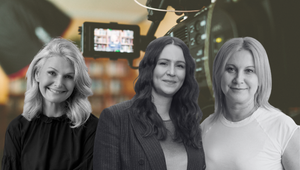
AI Uptake is "Well Past the Theory Stage." It's Already Changing Everything

The conversation around AI in advertising is getting loud, and for good reason, it’s clearly not just a blip or a passing trend. It’s reshaping everything -- from how ideas are conceived to how they’re sold to clients -- and the natural next shift is how they’re brought to life from script to screen.
Our antenna has been up for a while now, and we’ve been on an AI fact-finding mission. We’re not claiming to have it all figured out, but we are starting to notice a few things along the way as we start to work more with AI in our daily production lives.
One of the most striking aspects of AI right now is the rapid evolution of its tools. Every week there's something new. From generative video to synthetic voice and AI-enhanced animation -- what seemed improbable or unaffordable six months ago is suddenly doable.
More traditional agency and production workflows are being reshaped for effectiveness with the help of early adopters, such as AI consultants, while new roles, like head of creative technology and AI or chief AI innovation officer, are emerging all the time. We are well past the theory stage; this world is formed and already happening.
As a result, we’re constantly trying to carve out time with these AI-leads to stay in step with their latest thinking -- our knowledge needs to evolve just as quickly as theirs to be effective production partners.
For some time now, we’ve been utilising a combination of real imagery and AI in our treatment responses. We’re now also working on projects that incorporate AI into the final execution.
We recently pitched on an AI project for an agency, and it was a fascinating (and mildly terrifying) process. We combined live-action concepts with AI-generated imagery and motion to visualise something we could never create with just one of those on their own. It was a challenging process of trial and error, but also an incredibly valuable learning experience.
We can see the huge potential in this hybrid approach. Not to replace live-action but as a powerful creative and production tool, helping us previsualise faster, test ideas more ambitiously, and bring to life what would have been previously impossible within budget or timeline constraints. At the same time, it’s crucial not to reduce this work to "cheap and cheerful tech."
AI artists are bringing a learned skill and creative vision to the table using their eye, decision-making, and storytelling sense to create amazing new concepts. We certainly can’t afford to cheapen this craft just because it can potentially be done with fewer resources or less time.
Of course, these new possibilities come with some caveats. Copyright, ownership, usage rights, ethical boundaries -- it’s all murky right now, and these are the questions we are all asking ourselves all the time.
We’ve been digging a little deeper and having many conversations with copyright experts, exploring legal commentary about where the lines currently sit with IP. It’s a grey area, and probably will be for a while, but that shouldn’t mean inaction. It simply means we must stay informed, ask questions, and build safeguards as we go. Deep breaths, everyone, let's take this virtual leap together.
As we step over the threshold, we acknowledge the uneasiness that is prevalent across the industry right now. We’re hearing it from agency producers, editors, VFX leads, and even clients. But instead of resisting it or pretending to know all the answers, we’re choosing to embrace it by taking the time to test, learn, partner, and prepare. The real risk right now is doing nothing.
We’re actively exploring by working with directors who experiment with the tools in treatments and final outputs, collaborating with post-production partners to test how AI-enhanced imagery works with VFX, and staying closely connected with AI leads to track what’s emerging. We’re sharing what we’re learning openly and often with our team and our clients, so we can all stay a step ahead together.
We know the traditional production balance is shifting and AI will continue to grow as part of the mix -- we want to be there to help shape how it’s used. No one knows exactly where this lands, but one thing is clear: this isn't the time to sit on the sidelines. It’s time to lean in, get curious, and be the kind of production partner agencies and brands have always relied on.








